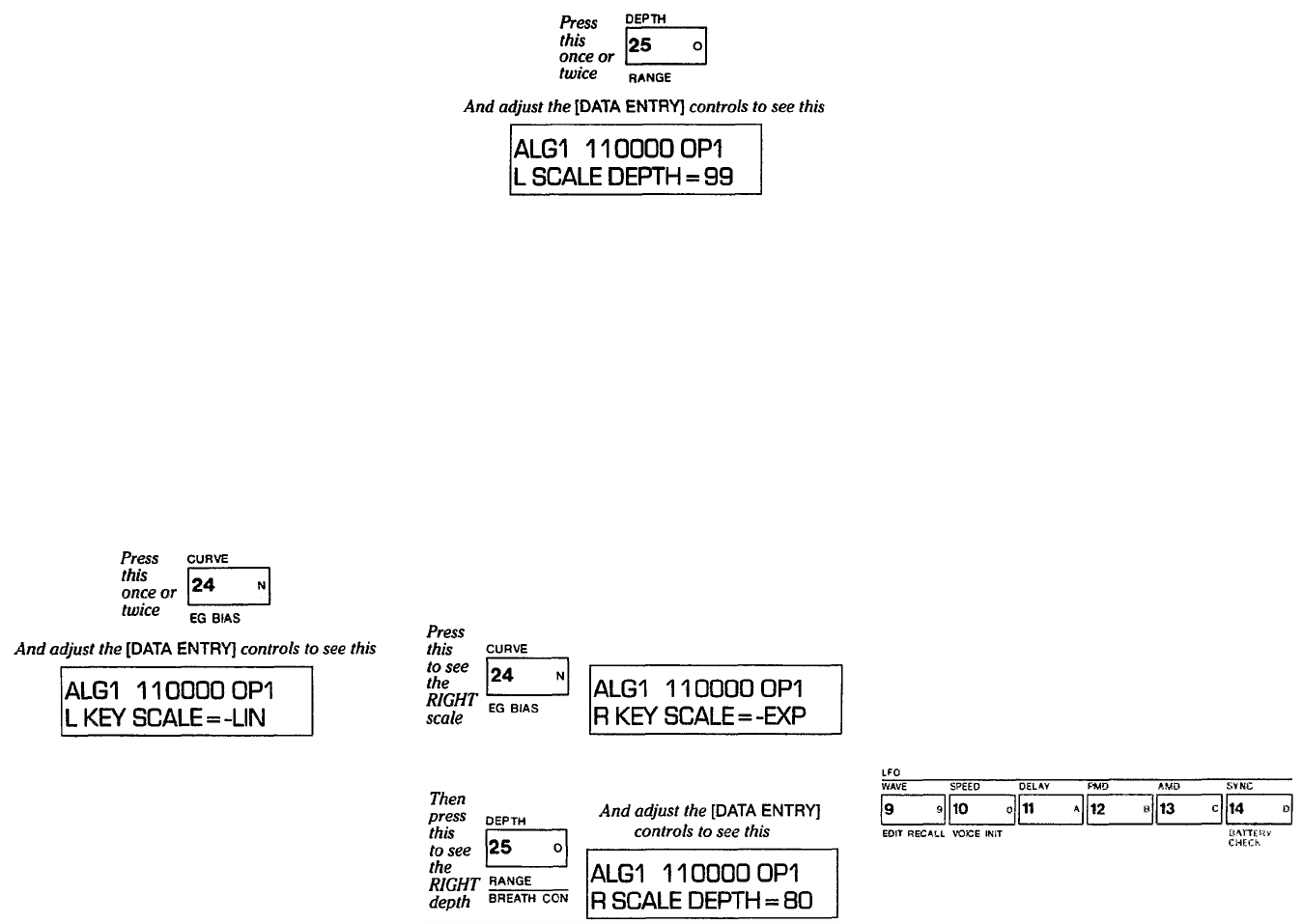
In this case scaling operator 2 is not necessary so you
can omit the process of setting its break point (which
would be done by pressing [OPERATOR SELECT]
and adjusting the value as desired).
Now play some scales and notice that the sound is
still reasonably uniform across the keyboard. That's
because, while we have selected a break point for the
carrier, we have not yet assigned any depth to the
curves on either side of the break point.
7. Basically there are two types of level scaling curves,
LINEAR and EXPONENTIAL. Linear curves seem to
cause a more rapid boost or cut and are useful for
exaggerated scaling effects, such as keyboard splitting.
Exponential curves are similar to the inherent loga-
rithmic sensitivity of our ears and therefore seem
more "natural". These curves are useful for simulating
the natural changes in level that occur across the
range of an acoustic instrument. Of course, the depth
and break point make a big difference, as does the
operator to which the scaling is applied (modulator or
carrier).
Press [CURVE] and observe the display It will either
show the curve set for the left or the right side of the
break point. If necessary press the button a second
time to ensure that the LEFT curve is displayed. Then
adjust [DATA ENTRY], if necessary, to select a "-LIN"
curve.
Now play some scales and notice how the sound
"goes away" as you move down the keyboard. While
the break point is set at E4, you probably won't hear
the sound getting quieter until you get to C4. By the
time you reach middle C, however, the level is down
about 22 dB. That's about 1/14 as loud. As you move
down the keyboard, the sound disappears. This is an
extreme example of level scaling, and a useful one as
you will hear. Lets leave the lower portion of the
keyboard "rolled off" for now.
9. As you play the highest notes on the keyboard, you
may find the sound to be unnaturally loud. In order
to scale this portion of the sound, you can set the
right curve and depth as follows:
Press the [CURVE] button to see what curve is set for
the right side, and adjust [DATA ENTRY], if neces-
sary to obtain a (-) exponential curve. Then press
[DEPTH] once or twice to see the RIGHT scaling
value and adjust [DATA ENTRY] to get a value of 80.
And adjust the [DATA ENTRY]
controls to see this
Now play up the scale from E4 and hear how you
have removed just a bit of volume from the highest
notes.
NOTE In the examples just given, the keyboard level
scaling may seem to have an effect mostly at the
higher number values, but that's because you were
adjusting a carrier Modulator levels tend to be more
critical,
and
you'll
hear
a
greater difference
in
some
voices than others, depending on the algorithm, the
particular location of the modulator within the "stack",
and the actual output level setting of the operator
Remember, also, that if you are "boosting" the level
with a positive (+) linear or exponential curve, you
have to begin with an Operator Output Level that is
less than 99; the lower the Operator Output Level
setting, the more range available for Keyboard Level
Scaling boost.
10. Press [OPERATOR SELECT], then use the KEY-
BOARD LEVEL SCALING buttons and [DATA EN-
TRY] to set operator 2 to a [BREAK POINT) of E4
with a "LIN" left [CURVE] and a left [DEPTH] of 99.
LFO
Modulation: The
relationship
between
the
"LFO"
settings
and
the
"MOD SENSITIVITY"
settings,
and how
to program these
The LFO section enables you to set the waveform
[WAVE] and frequency [SPEED] of a sub-audible oscilla-
tor. The LFO section has a button [PMD] that permits
you to preset the voice so a portion of that modulation is
applied to change the pitch of the voice (for anything
from vibrato-like effects to exaggerated, continuous pitch
bending). Simultaneously or instead, the same LFO
wave can be assigned to modulate the amplitude (level)
of each operator by using the [AMD] button. Amplitude
modulation can produce tremolo when applied to a
carrier, or "wah-wah" effects when applied to a modula-
tor — among other effects.
40
8. Set the depth of the left curve (the slope at which the
sound will roll off below the break point). Do so by
pressing [DEPTH] and observing the display which
will either indicate the LEFT or RIGHT depth; if nec-
essary press the button a second time to ensure that
the LEFT depth setting is displayed. Then push up
[DATA ENTRY] to obtain a maximum depth setting
of
99.
A critical concept to grasp is that the modulation you
select with these LFO buttons does not go directly to the
operators. It does not necessarily do what you've set it to
do unless you "open the gates" for the amplitude and/or
pitch modulation output of the LFO to get to the opera-
tors.- These "gates" are the Modulation Sensitivity adjust-
